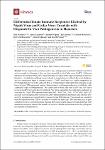Differential Innate Immune Responses Elicited by Nipah Virus and Cedar Virus Correlate with Disparate In Vivo Pathogenesis in Hamsters
Schountz, Tony
Campbell, Corey
Wagner, Kaitlyn
Rovnak, Joel
Martellaro, Cynthia
DeBuysscher, Blair L.
Feldmann, Heinz
Prescott, Joseph
Syrian hamsters (Mesocricetus auratus) are a pathogenesis model for the Nipah virus (NiV), and we sought to determine if they are also susceptible to the Cedar virus (CedPV). Following intranasal inoculation with CedPV, virus replication occurred in the lungs and spleens of infected hamsters, a neutralizing antibody was produced in some hamsters within 8 days post-challenge, and no conspicuous signs of disease occurred. CedPV replicated to a similar magnitude as NiV-Bangladesh in type I IFN-deficient BHK-21 Syrian hamster fibroblasts but replicated 4 logs lower in type I IFN-competent primary Syrian hamster and human pulmonary endothelial cells, a principal target of henipaviruses. The coinfection of these cells with CedPV and NiV failed to rescue CedPV titers and did not diminish NiV titers, suggesting the replication machinery is virus-specific. Type I IFN response transcripts Ifna7, Ddx58, Stat1, Stat2, Ccl5, Cxcl10, Isg20, Irf7, and Iigp1 were all significantly elevated in CedPV-infected hamster endothelial cells, whereas Ifna7 and Iigp1 expression were significantly repressed during NiV infection. These results are consistent with the hypothesis that CedPV’s inability to counter the host type I IFN response may, in part, contribute to its lack of pathogenicity. Because NiV causes a fatal disease in Syrian hamsters with similarities to human disease, this model will provide valuable information about the pathogenic mechanisms of henipaviruses.

